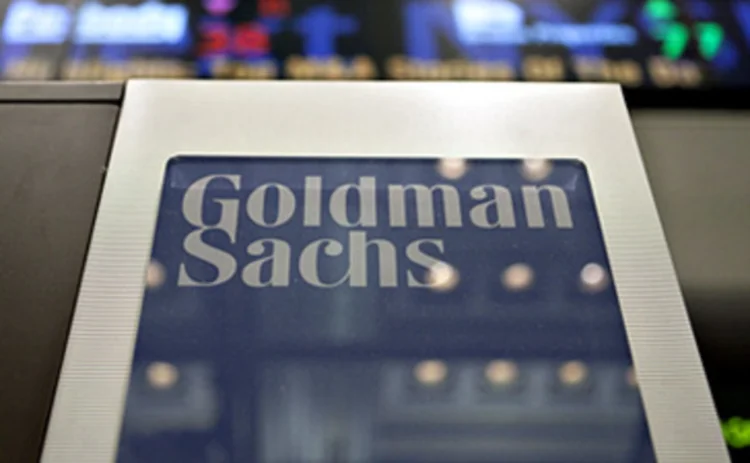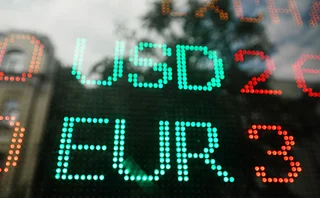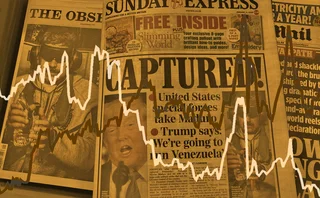
Goldman hid swaps profits from clients, whistleblower claims
In a complaint to the US Securities and Exchange Commission, a former Goldman Sachs employee has accused the bank of disguising how much profit it makes on some trades

Goldman Sachs has been accused of manipulating the valuation statements it sent to clients for certain derivatives trades, in order to mask the bank's profits. The claims appear in a whistleblower's complaint to the US Securities and Exchange Commission (SEC), seen by Risk.
The complaint, filed in August, alleges the bank sought to mislead clients by initially inflating daily trade valuations in the client's favour, before writing that value down over time and recognising increasing levels of profit for the bank. It claims the practice is known within Goldman as P&L amortisation, and is most commonly applied when the bank is "making a large amount of profit as a result of executing relatively complicated over-the-counter (OTC) trades".
"Most probably this practice is used by other banks as well, under the same name or different names," adds the complainant, who is a former employee of the bank. The complaint does not expressly allege any breaches of US securities law. A spokesman for the SEC in New York declined to comment on the complaint or its contents.
The complaint gives a hypothetical example in which a client buys an OTC option from Goldman. The mid-market price of the option is 60, while transaction and hedging costs, credit and funding charges and other reserves are 10. The walkaway price of the trade for Goldman would therefore be 70, the complaint says. "However, in this example, GS manages to sell the option to the client for 100 because the client is not sophisticated, didn't challenge the price and/or didn't seek competing offers."
The complaint states Goldman should therefore book a profit of 30 when the trade is executed. However, the complainant argues, if Goldman were to book 30 in profit immediately, "the valuation report that the client would receive as of the close of the trading day, assuming the market hasn't moved, would show 60, implying that the client lost 40 by entering into the trade – 10 due to transaction costs, which is justifiable; but 30 due to GSs profit, which is unjustifiable."
As an ex-GS employee, I am familiar with other cases. However, I don't have other supporting documents
When P&L amortisation is used, the complaint says, the client would not be shown the mid-market price for the transaction, and would instead be given an "unwind valuation" – this incorporates adjustments that initially make the trade appear more favourable for the client. In the example given, the valuation shows a small day one profit for Goldman, of five. The rest of the bank's profit – 25 – is treated as reserves.
Hidden reserve
The resulting unwind valuation would show the client a price of 85 – representing the actual price of 100, minus 10 to cover the bank's transaction costs, and profits of five. Within the bank, this would be seen differently, the complaint claims – a market price of 60, and a hidden reserve of 25.
In theory, a bank might seek to explain the reserve as a way to cover hedging, capital and other costs over the life of the trade; in practice, the complaint says the reserves will gradually be bled back into the trader's P&L, "according to a predetermined schedule or the discretion of GS". The end result is that the unwind price converges with the correct mid-market valuation of the trade. If these adjustments were not applied, the client would be able to see the true profit Goldman was making on the trade immediately, the complaint claims.
A spokesperson for Goldman Sachs in London declined to comment. However, it is understood the bank does provide mid-market or unwind valuations to clients, and prefers to use the former. Unwind valuations are understood to require ongoing input by traders, as well as co-ordination with client valuation teams. In contrast, mid-market valuations are model-generated, and much less costly and time-consuming for the bank to send to clients from an operational perspective.
Risk discussed the complaint with four derivatives valuation and accounting experts – with the names of the clients and other parties mentioned in the complaint redacted. Their views were mixed. Saul Haydon Rowe, a partner at London-based complex banking litigation support firm Turing Experts, sees it as a legitimate practice that is open to abuse.
"It's common policy for a bank to take a hedge reserve against a position where there is uncertainty about liquidity, inputs or model valuations. The process of amortising that reserve allows them to recognise any expected profit over the life of the trade that may not accrue on day one. But banks, accountants and regulators should be aware traders or other staff can potentially game the system so they can smooth their profit or manipulate bonuses. Any such manipulation could seriously impact the accuracy of a dealer's shareholder filings and compensation ratios," he says.
Common practice
Moorad Choudhry, professor in the department of mathematical sciences at Brunel University in London, says it is common practice for a bank to provide mid-market and unwind valuations side by side, with any disparity between the two being acknowledged and explained. The use of unwind valuations alone would be more unusual, but he argues a bank is free to account for its profits as it sees fit within the law.
"If one was doing that to avoid telling a client how much profit one was making from them, well, that might be a sharp-elbowed practice, but guess what: that's normal commercial practice in every industry. The client wouldn't know what its supplier's profit margin was for just about any product it purchased, whether it was a AAA-rated bond, an exotic derivative or a toaster," says Choudhry.
The complaint includes several attachments purporting to show evidence of the practice at Goldman. One is a pair of valuation statements – one a mid-market valuation, the other an unwind valuation – on a 20-year interest rate swap with a notional in excess of €100 million for a European state-backed client.
The trade date of the swap was early 2008. Goldman sent the client an unwind valuation report in June 2008.
The disclaimer to the unwind valuation notes: "If specifically stated, the valuation is the price at which Goldman Sachs is prepared to unwind or terminate the transaction at approximately the time specified... The attached valuation may not reflect the valuation you would obtain by using pricing models available from Goldman Sachs or from any other source, or which you would receive from another dealer, and is not necessarily indicative of values carried on our books and records."
In October 2009, Goldman sent the client a mid-market valuation report. The disclaimer to the mid-market valuation notes: "If a valuation listed in the attached information is designated as an ‘unwind price', then it represents the price at which Goldman Sachs or one of its affiliates (‘Goldman Sachs') is prepared to unwind the position. If a valuation is designated as a ‘midmarket valuation', then it represents either (1) Goldman Sachs good faith estimate of the midmarket value of the position, based on estimated or actual bids and offers for the positions, or (2) a ‘midmarket' price generated by proprietary valuation models utilized by Goldman Sachs."
The complainant says this shows the process of P&L amortisation was completed between the dates of the two reports: "If the adjustment was needed to hedge the position, Goldman would not have stopped using the adjustment by 2009, while the trade had a maturity date that falls in 2028, 19 years later."
The problem with indicative marks
Turing's Haydon Rowe adds: "In general, there is very little justification for giving clients indicative marks that are not the same as where a bank has marked an instrument on its own balance sheet. The whole practice of indicative marks is problematic in itself, but an opaque reserving policy can exacerbate it. Arguably, the use of indicative marks, which possibly differed significantly from balance sheet values, worsened the credit crisis by hiding expected losses from clients for too long. The whole market would benefit from clarity on this issue."
One senior debt capital markets banker says banks have routinely been accused of seeking to maximise profits from so-called sovereign, supranational or agency (SSA) clients – public or semi-public entities such as development banks or public-private partnerships.
"I've not seen specific allegations of this nature raised before. If it is true, it's terrible, particularly if public-sector clients are involved. But it's not news that dealers have sought to make as much money as possible from selling derivatives to SSA clients. Partly that's because they tend to be slightly less sophisticated in terms of pricing than institutional investors, but it's also because the types of derivatives many of them have tended to use are harder to value than a standard swap. They might also prefer to work very closely with only one bank, rather than shop around," says the banker.
The third attachment is an email chain, which, according to the complaint, shows Goldman executives discussing the valuation of a position owned by a different client, this time based in the US.
"We will be applying the same adjustment for [redacted] as the previous month?" asks one valuations executive on October 3, 2008. "Can we decrease the adj to 1% for the next valuation," responds a trader on October 10. This is followed by the request "Can we take off the remaining adjustment for the next valuation? Tks" on October 29, 2008.
According to the complaint, "the traders are discussing the amount by which to adjust the valuation reports that are sent to the client. This adjustment was used initially to inflate the valuation that the client received. At one point, the valuation was showing 8.29% (midmarket) + 1.78% (adjustment). However, in October 2008, the 1.78% was decreased to 1% and then to nil within the space of 20 days... if the adjustment was needed to protect against potential losses, Goldman would not have taken the entire amount by the end of October 2008 more than six months prior to the expiry of the trade."
The complainant concludes: "As an ex-GS employee, I am familiar with other cases. However, I don't have other supporting documents. I believe that the practice of P&L amortisation was widely spread within GS. Please do not hesitate to contact me should you require any further information."
Even if a bank is suspected of having manipulated valuations, it is often difficult to prove, if not impossible, says Jackie Bowie, London-based chief executive at independent financial risk management consultancy JC Rathbone.
"I've not seen specific evidence of this practice before, but it doesn't surprise me – particularly the reference to exotic trades, where an extra spread is routinely wrapped into the product. But even at the point of execution for a trade, it would be impossible for anyone to really know how much margin was included. Valuations can differ wildly from bank to bank, and the way positions are accounted for can differ even from desk to desk," says Bowie.
This complaint is not the first time Goldman has faced accusations of deliberately setting out to maximise profits by selling products to unsophisticated clients. In 2012, disgruntled former equity derivatives salesman Greg Smith accused the bank of routinely targeting the sale of complex products to naive clients in order to maximise profits. An internal enquiry by the bank found no evidence of the practice. It later emerged Smith had left shortly after receiving a bonus that was significantly lower than he had sought.
In 2010, the bank paid a record $550 million settlement to the SEC over claims it misled investors in a subprime mortgage product – a synthetic collateralised debt obligation (CDO) known as Abacus 2007-AC1 – as the US housing market was starting to collapse. The bank failed to disclose in marketing materials for the CDO that some of the mortgages it referenced had been selected by Paulson & Co, a hedge fund manager that was short the CDO.
Only users who have a paid subscription or are part of a corporate subscription are able to print or copy content.
To access these options, along with all other subscription benefits, please contact info@risk.net or view our subscription options here: http://subscriptions.risk.net/subscribe
You are currently unable to print this content. Please contact info@risk.net to find out more.
You are currently unable to copy this content. Please contact info@risk.net to find out more.
Copyright Infopro Digital Limited. All rights reserved.
As outlined in our terms and conditions, https://www.infopro-digital.com/terms-and-conditions/subscriptions/ (point 2.4), printing is limited to a single copy.
If you would like to purchase additional rights please email info@risk.net
Copyright Infopro Digital Limited. All rights reserved.
You may share this content using our article tools. As outlined in our terms and conditions, https://www.infopro-digital.com/terms-and-conditions/subscriptions/ (clause 2.4), an Authorised User may only make one copy of the materials for their own personal use. You must also comply with the restrictions in clause 2.5.
If you would like to purchase additional rights please email info@risk.net
More on Markets
S&P bull run drives interest in reset and lookback hedges
Variable strike put options proved popular alternative hedging format of 2025
US mutual funds slash short euro positions at record pace
Counterparty Radar: Pimco cut $4.6bn of EUR/USD puts in Q3 amid changing stance on dollar direction
Nomura hires new global eFX head
Mark McMillan to oversee e-trading and sales activities in newly created role
Trump’s LatAm gambit spurs FX hedging rush
Venezuela op boosts risk reversals as investors look to protect carry trades
One Trading brings 24/7 equity trading to Europe
Start-up exchange will launch perpetual futures Clob in Q1 after AFM nod
FXGO volumes surge despite fee switch-on
Dealers split on whether levy is behind volume increases across SDPs
Banks hope new axe platform will cut bond trading costs
Dealer-backed TP Icap venture aims to disrupt dominant trio of Bloomberg, MarketAxess and Tradeweb
Kyriba sees uptake in AI-assisted FX hedging tools
Automated data collection and cleaning helps corporates create better hedges and has cut unexplained P&L moves by 87%, says vendor








